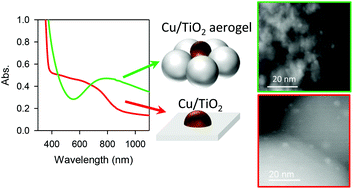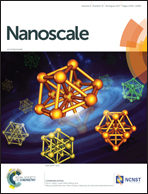Oxidation-stable plasmonic copper nanoparticles in photocatalytic TiO2 nanoarchitectures†
Abstract
Ultraporous copper/titanium dioxide (Cu/TiO2) aerogels supporting <5 nm diameter copper nanoparticles are active for surface plasmon resonance (SPR)-driven photocatalysis. The extended nanoscale Cu‖TiO2 junctions in Cu/TiO2 composite aerogels—which arise as a result of photodepositing copper at the surface of the nanoparticulate-bonded TiO2 aerogel architecture—stabilize Cu against oxidation to an extent that preserves the plasmonic behavior of the nanoparticles, even after exposure to oxidizing conditions. The metallicity of the Cu nanoparticles within the TiO2 aerogel is verified by aberration-corrected scanning transmission electron microscopy, electron energy-loss spectroscopy, and infrared spectroscopy using CO binding as a probe to distinguish Cu(0) from Cu(I). In contrast, photoreduction of Cu(II) at a commercial nanoscale anatase TiO2 powder with primary particle sizes significantly larger than those in the aerogel results in a copper oxide/TiO2 composite that exhibits none of the plasmonic character of Cu nanoparticles. We attribute the persistence of plasmonic Cu nanoparticles without the use of ligand stabilizers to the arrangement of Cu and TiO2 within the aerogel architecture where each Cu nanoparticle is in contact with multiple nanoparticles of the reducing oxide. The wavelength dependence of the photoaction spectra for Cu/TiO2 aerogel films reveals visible-light photocatalytic oxidation activity initiated by an SPR-driven process—as opposed to photo-oxidation initiated by excitation of narrow-bandgap copper oxides.



 Please wait while we load your content...
Please wait while we load your content...